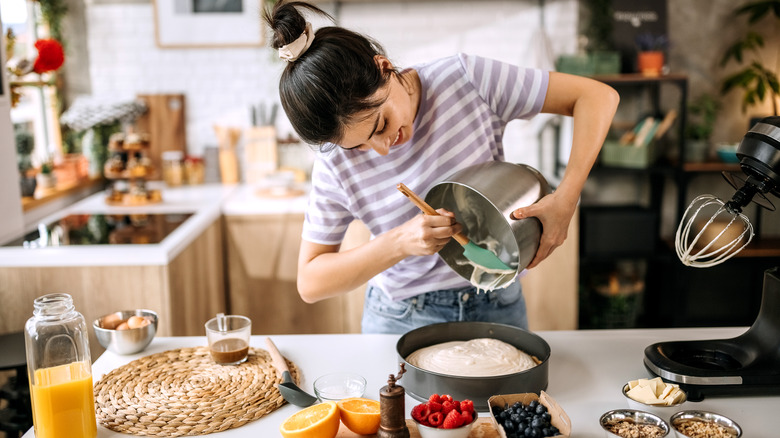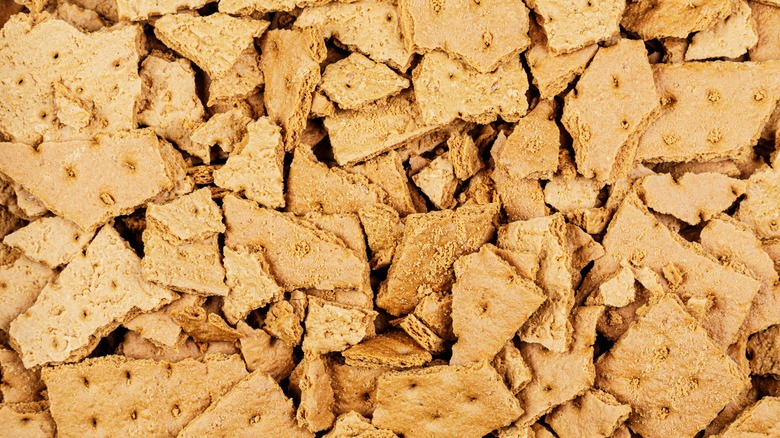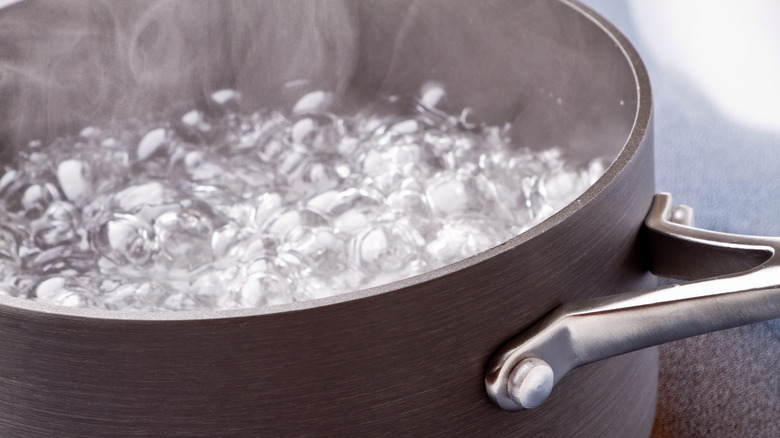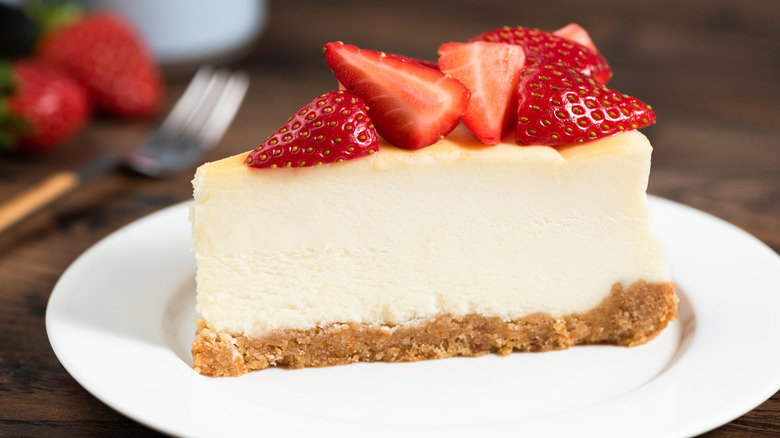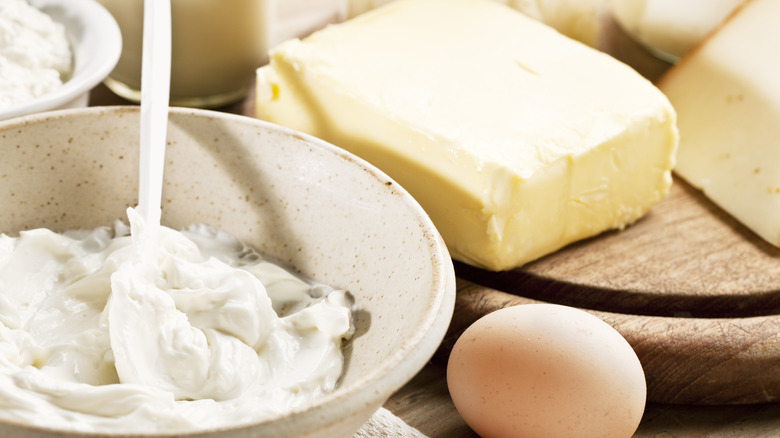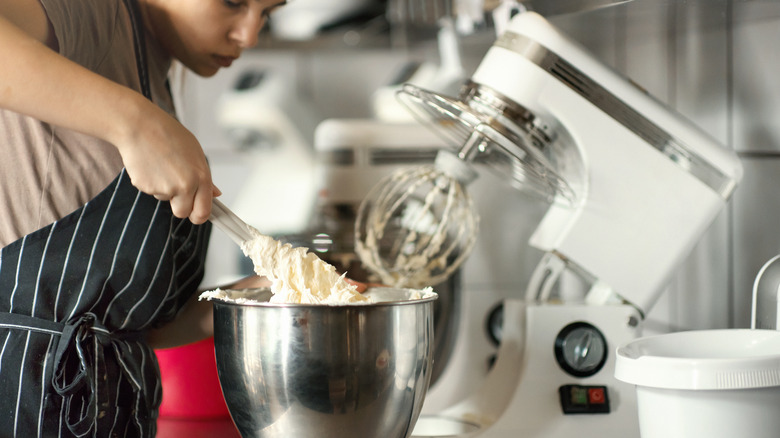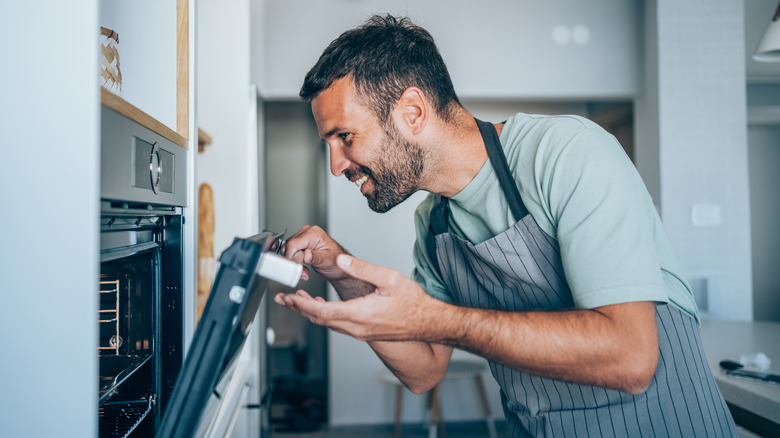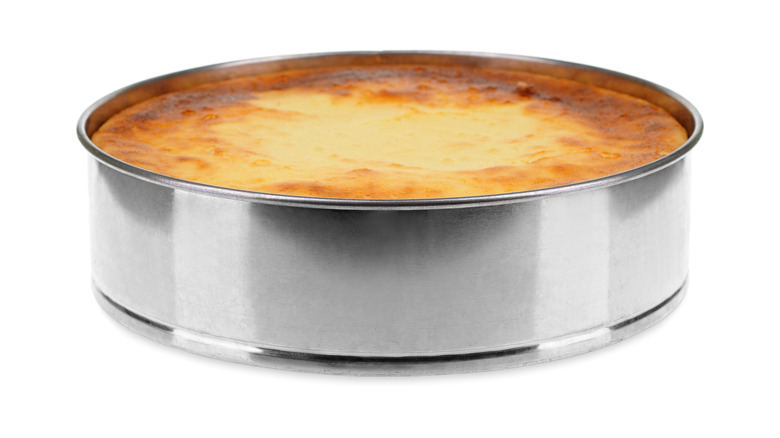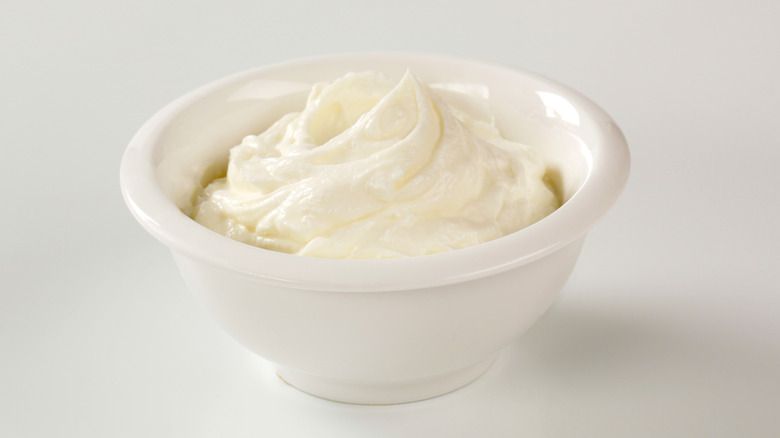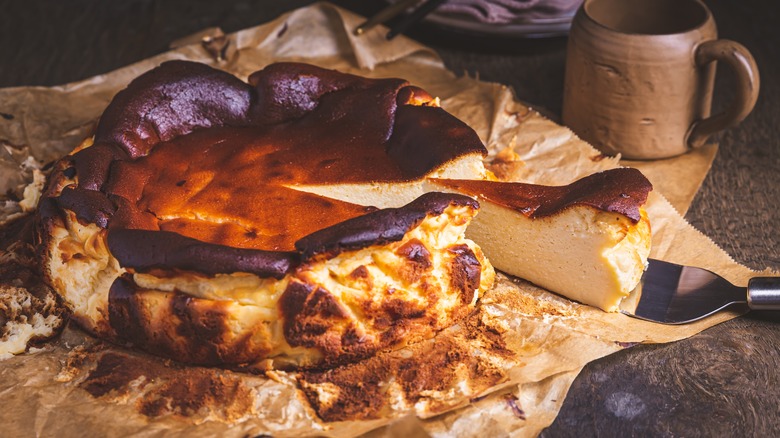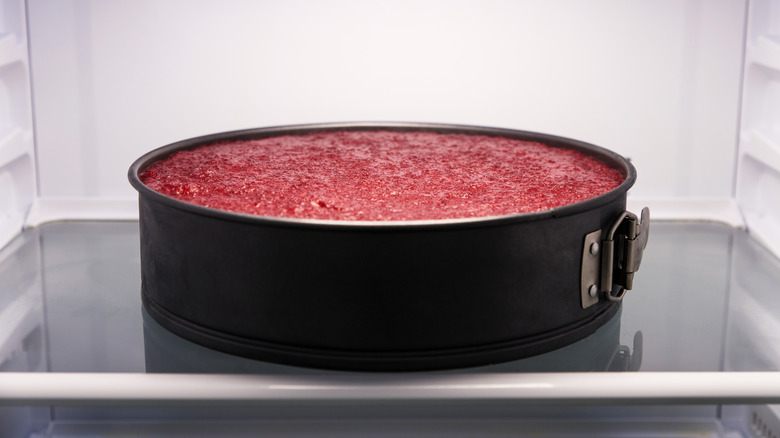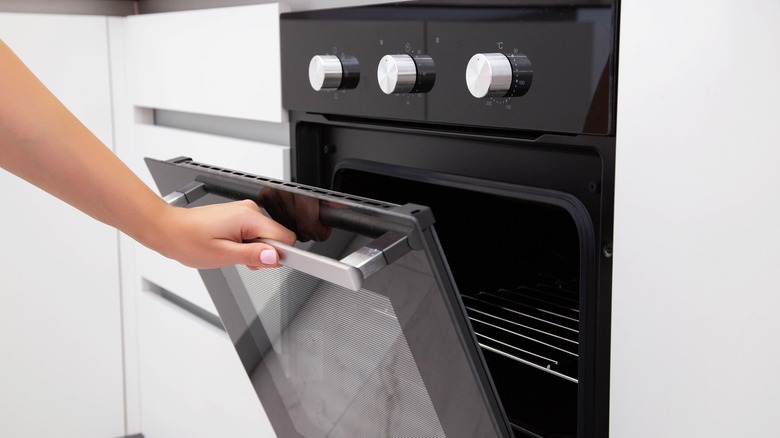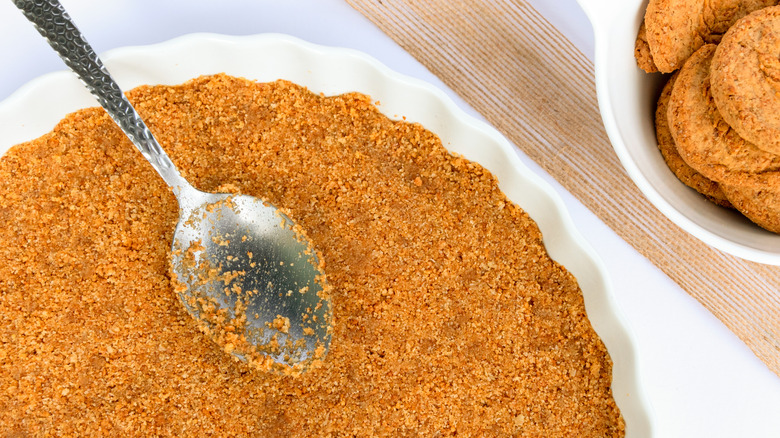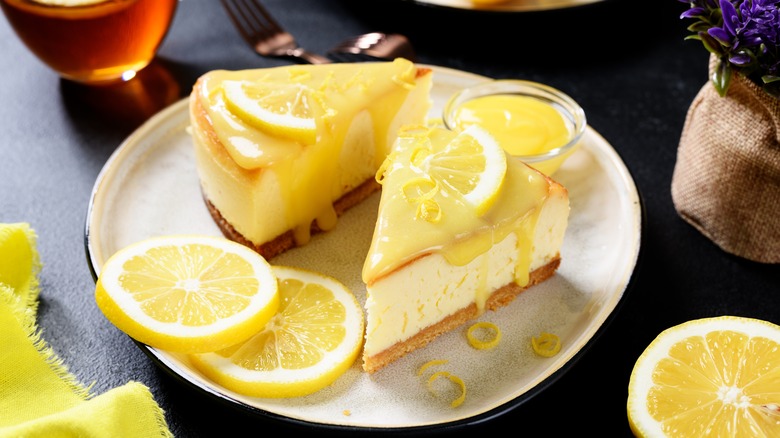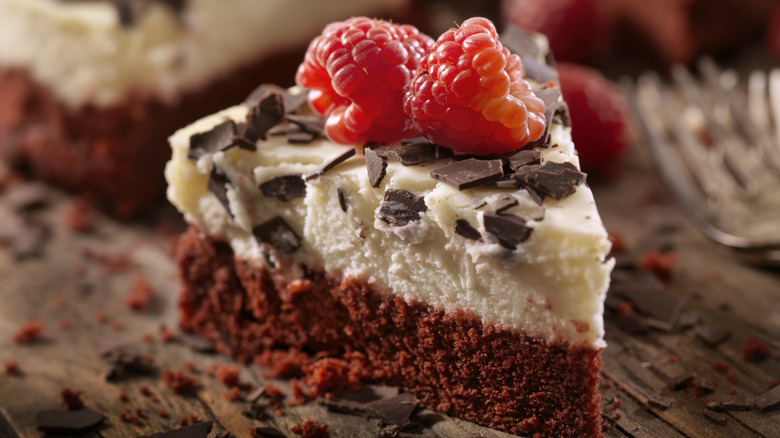14 Common Mistakes Everyone Makes With Homemade Cheesecake
People have been enjoying cheesecake since way back in the 5th century BCE, when the Greeks crushed up cheese with some flour and an egg and baked it under a brick. The recipe has come a long way since then, especially after the creation of cream cheese in 1872, and now it is one of America's most beloved desserts. While there are plenty of commercially available cheesecakes out there, there is nothing quite like making one on your own. Unfortunately, this is not always easy.
Cheesecake seems simple. The basic recipe has just three ingredients: cream cheese, eggs, and sugar (and a graham cracker crust, usually). But, things are not as straightforward as they may seem, as cheesecake is a very delicate, easy-to-ruin dessert. If you have ever worked hard to make the perfect cheesecake, only to take it out of the oven with a big crack through the middle (the worst thing that can happen, according to most cheesecake enthusiasts), you will know what we mean.
But don't worry! We can help take your cheesecake from mediocre to magnificent with this list of all-too-common mistakes you need to know before baking another cheesecake. If you avoid these slip-ups, you'll have a delicious homemade cheesecake on your hands in no time.
1. Mistake: Not crushing your graham crackers enough
Making any kind of pie crust can be tough at times. Sometimes it doesn't stretch enough to cover the bottom, sometimes it gets holes when you spread it, sometimes it's too thick or too thin or gets too hard in the oven. The beauty of graham cracker crusts is that they don't usually lead you to any of these pitfalls. You just crush up graham crackers, mix them with melted butter and sugar, and you're good to go.
Sometimes, though, you might find that it's not as easy as it looks. If you don't crush up the graham crackers just right, your crust is going to be chunky. This makes it not only look bad, but also makes it less structurally sound and more likely to break apart when you go to cut into the cake. So, what's a crust-maker to do? The best way to avoid this extremely common cheesecake-making mistake is to use a food processor to crush up the graham crackers. This breaks them into small, uniform crumbs that will hold together better when mixed with the other ingredients.
2. Mistake: Not using a water bath
One thing that should never be neglected when baking a cheesecake is the use of a double boiler to give your dessert a water bath. Or, if you don't have a double boiler, you can use two pans, one larger and one smaller. It might sound strange, but placing your cheesecake pan in a pan of water, also known as a bain-marie, is the key to getting perfectly browned sides and a smooth, crackless, unburnt top.
All you need to do is fill a large pan (large enough for your cheesecake pan to fit in comfortably with a bit of a moat around it) with hot water. Don't forget the "hot" part: If you add cold water to the pan, it will change the temperature of the cheesecake and the oven and this whole plan will fall apart. If you are worried about the water seeping into the springform pan, you can seal up the crack between the sides and bottom by wrapping it in tin foil. Then, just put the pan-within-a-pan in the oven and bake as usual. Be very careful not to splash yourself or your cheesecake, though! No one wants a watery cheesecake or a scalded chef.
3. Mistake: The sides of your crust are too low
Another very common mistake made by at-home cheesecake makers is that the sides of their crust are too low. The sides of the crust must obviously be high enough to hold in the filling, but this is not the only problem here. The main issue is that, if you don't press your graham cracker crust up over the seam of your springform pan, your filling will leak out through the small gap between the sides and the bottom of the pan during the baking process.
Depending on the extent of the leakage, this is something that can't really be fixed and can lead to big messes in your oven, not to mention a very imperfect cheesecake. Pressing your crust up high enough is all you need to do to avoid a disaster, however, and it will also lead to a very pretty, perfectly encased cheesecake.
4. Mistake: Not using room temperature ingredients
As we have already mentioned, a crack in the top of a cheesecake is basically a death sentence (well, the death of your dreams of a perfect cheesecake, anyway). If you want to avoid this, you can start by paying attention to the temperature of the ingredients. It would make sense to use cold cream cheese, cream, and even eggs since you usually keep them in the refrigerator, but this is a mistake! You should bring all of your ingredients to room temperature before you get started.
Cheesecake is very delicate, and changes in temperature are one of the easiest ways to ruin it. If you add ingredients that are different temperatures, they may not mix together properly in the bowl. And, even worse, if you put a cold cheesecake in a hot oven, the temperature will rise too fast and cause the filling to firm up and then split. Fortunately, all you need to do to keep this from happening is to get your ingredients out of the fridge ahead of time so they can warm up.
5. Mistake: Overmixing the filling
For most cakes, adding air to the batter is key to getting a big, fluffy result. However, when it comes to cheesecake, this is a big mistake. While it is obviously necessary to combine your ingredients, beating them too much with a mixer or with a handheld whisk or spoon will add too much air into the filling, which is — you guessed it — another leading cause of cheesecake cracks.
One of the best ways to avoid this is to mix the batter gently by hand with a spatula and stop when you can no longer see any streaks in the mixture. It should be thoroughly mixed but not overmixed, which can be a tough line to walk. Basically, for just this one baked good, forget everything you learned about how important it is to incorporate air into the batter, and stir only until it all comes together. Cheesecake doesn't need to rise, so it doesn't need any extra airy boost.
6. Mistake: Opening the oven door while your cheesecake is baking
Are you looking for another way to create cracks in your cheesecake? (There are a lot of them, as you may have realized by now.) Then you're gonna love this one: opening the door of the oven while your cheesecake is baking.
As mentioned in other sections, cheesecake is very susceptible to temperature changes. If you open the oven door while it is inside, doing its thing, you will introduce cooler air and let out the steam and the heat that has been accumulating inside. While for many baked goods this might just lead to a longer baking time, when it comes to cheesecake, this can potentially lead to a cracked surface. So, even if you really, really want to check for one second if the cake still feels gooey, or just give it a little turn, resist the temptation. Leave the cheesecake alone until it is done, and you will be rewarded for your patience with a beautiful dessert.
7. Mistake: Not loosening the cheesecake from the pan soon enough
While many of the mistakes on this list have referred to cracks that can form during the baking process, there is another kind of crack that can form: the kind that shows up when it cools down. But never fear! Even these cracks can be avoided with a little thinking ahead.
All you have to do is gently run a knife around the edge of the cheesecake, between the crust and the sides of the pan, as soon as it comes out of the oven. This will give it the freedom to contract without splitting as it cools and will make it easier to detach the crust from the pan in general. Once the cheesecake has been chilled, remove the ring of the springform pan completely — something that will be a lot easier since you loosened it up beforehand. Implementing this trick ensures that your crust will be perfectly intact and your cheesecake will be perfectly uncracked, thanks to your planning ahead.
8. Mistake: Trying to make a low-fat cheesecake
No one would ever dream of blaming you for wanting to try to watch what you eat and make healthier food choices. Eating low-fat or fat-free foods can be a great way to get or stay in shape, but those low-fat foods have no place in cheesecake making.
While there are low-fat cream cheeses out there, you can't use these in your cheesecake. They have a much higher moisture content than full-fat cream cheese, which means that your filling won't get dense and will most likely end up being unappealingly watery. Also, since these diet-friendly alternatives don't have fat in them, additives and stabilizers have been mixed in to give them the proper cream cheese texture. But these stabilizers and additives are not as stable as their name implies, and they break down when they are exposed to heat, leaving you with a soggy, wet mess. The same is true if you are adding cream or sour cream to your cheesecake: You have to use the full-fat kind if you want it to turn out correctly. This might ruin your diet for a day, but at least you won't ruin your cheesecake!
9. Mistake: Overbaking your cheesecake
Overbaking is yet another way to create cracks in your cheesecake. While Basque cheesecake uses a special technique to burn and caramelize the top, if you're not following this specific method than overbaking can also lead to a crumbly, dry texture that neither looks nor tastes good. Cheesecake is a type of custard, which means that the interior of the cake is never truly "done" in the way that a chocolate cake would be, for example. It will always be a little jiggly, but how can you know if it's too jiggly?
One way to test your cheesecake for doneness is to tap the side of the pan with a wooden spoon. If the cake jiggles a tiny bit in the center, it is done. If the entire surface ripples like waves on an ocean, it's not. If it doesn't jiggle at all, it is either overbaked or getting there, so you should take it out ASAP.
If you prefer a more scientific and less subjective method of checking whether or not your cheesecake is done, you can use a cooking thermometer. The center of your cheesecake should be 145 degrees Fahrenheit when it is ready to come out of the oven.
10. Mistake: Putting it in the refrigerator too soon
Any sudden or big change in temperature spells trouble for your cheesecake. While it is true that cheesecakes are a refrigerated treat, they should not go straight from the oven to the fridge. You have to cool them down slowly, gradually, so that they won't break or crack.
One way to do this is to start by turning off the oven and letting your cheesecake rest inside for thirty minutes. Then, wedge the handle of a wooden spoon between the door and the oven and let it cool down for another half hour. Once that time has passed, take out the cheesecake and place it on the counter, where you should let it rest for at least three more hours. After that, it should have reached room temperature and can be placed in the refrigerator.
Cheesecakes are not a quick dessert to whip up in the hour or two before company arrives. They need their time to adjust to the correct temperature and to fully set, so always keep that in mind when you make a plan to bake one.
11. Mistake: Not using the correct oven temperature
As with most baked goods, oven temperature is very important for cheesecake. This type of dessert tends to overcook, so it is important not just to keep an eye on your cheesecake while it bakes, but also to make sure that it is baking at the right temperature.
That being said, there is more than one way to bake a cheesecake. If you want a firmer, more solid cheesecake, you should bake it at 450 degrees Fahrenheit for 20 minutes. You should then prop open the oven door with the handle of a wooden spoon for 10 minutes, then close the door and restart the oven at 250 degrees Fahrenheit. This will allow the proteins in the egg to come together tightly, and quickly, and will also make for a nice, golden brown top.
If creamier cheesecake is more appealing to you, then you should bake it at 250 degrees Fahrenheit for the entire cooking time. This will mean a paler, softer cheesecake that will have a smooth filling and a less airy texture.
12. Mistake: Not pre-baking your crust
Some people prefer the graham cracker crust of their cheesecake to be softer and easier to cut. This is a fine way to eat it, but it may also lead to breakage or seepage. If you like a crisper texture and a more solid foundation for your cheesecake, you should pre-bake the crust. This will also give it a toasty flavor that is a great complement to the sweet, cheesy filling.
To pre-bake your crust, press it into the pan as you normally would, then put it in a preheated oven at 375 degrees Fahrenheit for eight to 10 minutes. This solo baking time allows the crust to set so that the moisture from the filling doesn't seep into it and make it soggy. Once it is slightly hard, remove the crust from the oven and let it cool down. Remember, temperature is always important with cheesecake. Don't put cold filling into a hot crust. Everything should be room temperature when it comes together to get the best results.
13. Mistake: Adding your toppings too soon
Toppings like fruit, pie filling, chocolate sauce, or melted caramel are a fantastic addition to cheesecake. They look terrific and they bring this already delectable dessert to a whole new level. But, as we have said, cheesecake is a finicky dessert, and it doesn't stop being finicky when it comes time to add toppings.
Decorating your cheesecake too soon can lead to a soggy, soupy cake or, at the very least, runny colors from your candy or fruit. To avoid this, only add your toppings right before you are going to serve it, so your guests will see it at the peak of its perfection.
It is also important to wait until the cheesecake is completely stable and set before decorating. You should let it rest for at least six to eight hours before topping it with anything, otherwise it may not be the right temperature or texture to support the toppings.
14. Mistake: Not trying different cheesecake varieties
As wonderful as a classic cheesecake is, one of the biggest mistakes you could make is not realizing that there is a whole world of different cheesecakes out there to make. There are baked cheesecakes like New York-style cheesecake, Basque burnt cheesecake, black tie cheesecake, turtle cheesecake, apple pie cheesecake, chocolate cheesecake, truffle cheesecake, almond cheesecake, and pumpkin cheesecake. Then there are unbaked ones made that are whipped together with cream cheese and whipped cream or Cool Whip and put in the fridge to set up, requiring much less time and effort with no less reward. There are cheesecakes with crusts made of crushed Oreos or other cookies and topped with chocolate shavings. Cheesecakes with homemade shortbread crust. Cheesecakes with cherry pie filling on top or fruity gelatin mixtures or streaks of caramel. There are even marble cheesecakes swirled with chocolate that look as great as they taste. There is a lot more to cheesecake than just cream cheese and a graham cracker crust, so it would be a shame not to think outside the cake box!
